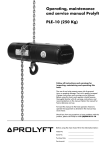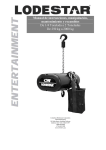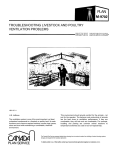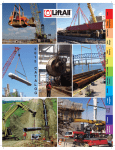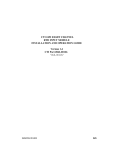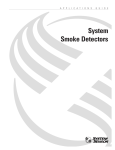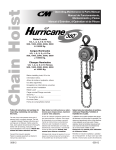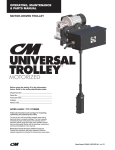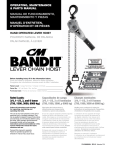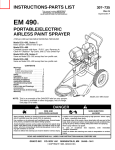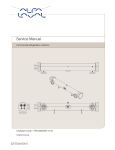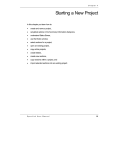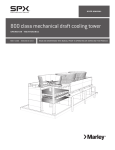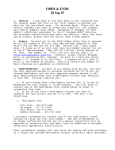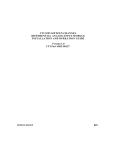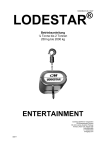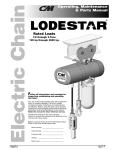Download ProStar Maintenance Manual
Transcript
PROSTAR Columbus McKinnon Entertainment Division Operating, Maintenance & Parts Manual Follow all instructions and warnings for inspecting, maintaining and operating this hoist. The use of any hoist presents some risk of personal injury or property damage. That risk is greatly increased if proper instructions and warnings are not followed. Before using this hoist, each operator should become thoroughly familiar with all warnings, instructions, and recommendations in this manual. Retain this manual for future reference and use. Forward this manual to the hoist operator. Failure to operate the equipment as directed in the manual may cause injury. Before using the hoist, fill in the information below: Capacity Serial No. Voltage Purchase Date Capacities 250 lb (113 Kg) 300 lb (136 Kg) 500 lb (226 Kg) 600 lb (272 Kg) 1,000 lb (453 Kg) 20875 Revision P620-G LIFETIME WARRANTY Every Columbus McKinnon Corporation hoist is thoroughly inspected and performance tested prior to shipment from the factory. If any properly installed, maintained and operated hoist as outlined in the applicable accompanying Columbus McKinnon hoist manual develops a performance problem due to defective materials or workmanship as verified by Columbus McKinnon Corporation, repair or replacement of the hoist will be made to the original purchaser without charge and the hoist will be returned, transportation prepaid. This warranty does not apply where deterioration is caused by normal wear, abuse, improper or inadequate power supply, improper or inadequate maintenance, eccentric or side loading, overloading, chemical or abrasive actions, excessive heat, unauthorized modifications or repairs, or use of non-Columbus McKinnon Corporation repair parts. EXCEPT AS STATED HEREIN, COLUMBUS MCKINNON CORPORATION MAKES NO OTHER WARRANTIES, EXPRESS OR IMPLIED, INCLUDING WARRANTIES OF MERCHANTABLILITY AND FITNESS FOR A PARTICULAR PURPOSE. Alterations or modifications of equipment and use of non-factory repair parts can lead to dangerous operation and injury. TO AVOID INJURY: • Do not alter or modify equipment • Do not use equipment to lift, support or otherwise transport people • Do not suspend unattended loads over people ® Country Club Road P.O. Box 779 Wadesboro, North Carolina 28170 Phone (800) 477-5003 Fax (800) 374-6853 © 2008CM® 140 John James Audubon Parkway Amherst, New York 14228-1197 Phone (800) 888-0985 Fax (800) 210-9480 Printed in USA 12/08 SAFETY PRECAUTIONS Each Prostar Electric Hoist is built in accordance with the specifications contained herein and at the time of manufacture complied with our interpretation of applicable sections of the National Electrical Code (ANSI/NFPA 70). Installers are required to provide current overload protection and grounding in keeping with the code. Check each installation for compliance with the applicable sections of the code as well as the National, State and Local Codes that may apply to the installation. In addition, safety code requirements associated with the operation of a hoist in the inverted (theatrical) position (chain port up), as with any mechanical equipment, vary depending upon locality. Therefore, before installing the hoist, the user should consult his insurance company and/or local authority to see if a deviation is required to permit the use of the hoist in this particular application. The safety laws for elevators, lifting of people and for dumbwaiters specify construction details that are not incorporated into the hoists. For such applications, refer to the requirements of applicable state and local codes, and the American National Safety Code for elevators, dumbwaiters, escalators and moving walks (ASME A17.1). We cannot be responsible for applications other than those for which the equipment is intended. THIS SYMBOL POINTS OUT IMPORTANT SAFETY INSTRUCTIONS WHICH IF NOT FOLLOWED COULD ENDANGER THE PERSONAL SAFETY AND/OR PROPERTY OF YOURSELF AND OTHERS. READ AND FOLLOW ALL INSTRUCTIONS IN THIS MANUAL AND ANY PROVIDED WITH THE EQUIPMENT BEFORE ATTEMPTING TO OPERATE YOUR PROSTAR HOIST. WARNING Improper operation of a hoist can create a potentially hazardous situation which, if not avoided, could result in death or serious injury. To avoid such a potentially hazardous situation, the operator shall: 1. 2. 3. 4. 5. 6. 7. 8. 9. 10. 11. 12. 13. 14. 15. 16. 17. 18. 19. 20. 21. 22. 23. 24. 25. 26. 1 NOT operate a damaged, malfunctioning or unusually performing hoist. NOT operate the hoist until you have thoroughly read and understood this Operating, Maintenance and Parts Manual. NOT operate a hoist which has been modified. NOT lift more than rated load for the hoist. NOT use hoist with twisted, kinked, damaged, or worn load chain. NOT use the hoist to lift, support, or transport people. NOT lift loads over people. NOT operate a hoist unless all persons are and remain clear of the supported load. NOT operate unless load is centered under hoist. NOT attempt to lengthen the load chain or repair damaged load chain. Protect the hoist’s load chain from weld splatter or other damaging contaminants. NOT operate hoist when it is restricted from forming a straight line from hook to hook in the direction of loading. NOT use load chain as a sling, or wrap load chain around load. NOT apply load to the tip of the hook or to the hook latch. NOT apply the load unless load chain is properly seated in the chain wheel(s) or sprocket(s). NOT apply load if bearing prevents equal loading on all load supporting chains. NOT operate beyond the limits of the load chain travel. NOT leave load supported by the hoist unattended unless specific precautions have been taken. NOT allow the load chain or hook to be used as an electrical or welding ground. NOT allow the load chain or hook to be touched by a live welding electrode. NOT remove or obscure the warnings on the hoist. NOT operate a hoist on which the safety placards or decals are missing or illegible. NOT operate a hoist unless it has been securely attached to a suitable support. NOT operate a hoist unless load slings or other approved single attachments are properly sized and seated in the hook saddle. Take up slack carefully - make sure load is balanced and load holding action is secure before continuing. Shut down a hoist that malfunctions or performs unusually and report such malfunction. 27. Make sure hoist limit devices function properly. 28. Warn personnel of an approaching load. CAUTION Improper operation of a hoist can create a potentially hazardous situation which, if not avoided, could result in death or serious injury. To avoid such a potentially hazardous situation, the operator shall: 1. 2. 3. 4. 5. 6. 7. 8. 9. 10. 11. 12. 13. 14. 15. Maintain a firm footing or be otherwise secured when operating the hoist. Check brake function by tensioning the hoist prior to each lift operation. Use hook latches. Latches are to retain slings, chains, etc. under slack conditions only. Make sure the hook latches are closed and not supporting any parts of the load. Make sure the load is free to move and will clear all obstructions. Avoid swinging the load or hook. Make sure hook travel is in the same direction as shown on the controls. Inspect the hoist regularly, replace damaged or worn parts, and keep appropriate records of maintenance. Use factory parts when repairing the unit. Lubricate load chain per instructions in this manual. NOT use the hoist load limiting or warning device to measure load. NOT use limit devices as routine operating stops unless allowed by manufacturer. They are emergency devices only. NOT allow your attention to be diverted from operating the hoist. NOT allow the hoist to be subjected to sharp contact with other hoists, structures, or objects through misuse. NOT adjust or repair the hoist unless qualified to perform such adjustments or repairs. TABLE OF CONTENTS Safety Precautions .............................................................1 Specifications......................................................................2 Installation ..........................................................................3 Operating Instructions ........................................................5 Maintenance .......................................................................6 Trouble Shooting ..............................................................10 Electrical Data...................................................................11 Disassembly-Assembly ....................................................13 Repair Parts......................................................................14 Exploded View..................................................................16 Replacement Parts List ....................................................18 Warranty ............................................................Back Cover Figure 1A Figure 1B SPECIFICATIONS REPAIR/REPLACEMENT POLICY The Prostar Electric Chain Hoist is a highly versatile materials handling device that can be used to lift loads that are within its rated load capacity. It is available in five load ratings: 250, 300, 500, 600 and 1,000 pounds (113,136, 226, 272 and 453 kg). Standard features of the Prostar Electric Chain Hoist include: • Alloy steel, oblique lay liftwheel that provides constant chain speed and reduces chain wear. • Hoistaloy® load chain for long and dependable service. • Grease lubricated, hardened spur gears provide smooth and quiet operation. • Thermally protected, hoist duty motor. • Forged steel upper and lower hooks with latch. • Protector™ that prevents lifting dangerous overloads. • D.C. disc type motor brake plus regenerative braking. • Standard Less Chain Unit. Longer lifts can be supplied on a per order basis. • 3 foot (.9 M) power cord with provisions for grounding is standard on 115-50/60, 220-1-50 and three phase units. • 3 foot (.9M) is standard for all control cords. Longer cords can be provided on a per order basis. • Lightweight die cast aluminum frames and covers. • Ball or needle bearings at all rotating points. • Compact, yet rugged, design provides minimum headroom and long, trouble-free service. • 6 fpm (1.8 m/min) lift speed available on 1000 lbs (453 kg) units. • 8 fpm (2.4 m/min) lift speed available on 500-600-1000 lbs (226, 272 and 453 kg) units. • 12 fpm (3.6 m/min) lift speeds available on 500-6001000 lbs (226, 272 and 453 kg) units. • 16 fpm (4.9 m/min) lift speeds available on 250-300500 lbs (113, 136 and 226 kg) units. • 20 fpm (6.1 m/min) lift speeds available on 500-600 lbs (226 and 272 kg) units. • 24 fpm (7.3 m/min) lift speeds available on 250-300500 lbs (113, 136 and 226 kg) units. • 40 fpm (12.2 m/min) lift speeds available on 250-300 lbs (113 and 136 kg) units. • 220-1-50, 380 to 460-3-50/60, 220 to 240-3-50/60 and 575-3-60 units available. Lift speeds are based on 60 hertz power supply. For 50 hertz power supply lift speeds will be 5/6 of those indicated. • UL and cUL listed. • Lifetime Warranty. All Prostar Electric Chain Hoists are inspected and performance tested prior to shipment. If any properly maintained hoist develops a performance problem, due to a material or workmanship defect, as verified by the factory, repair or replacement of the unit will be made to the original purchaser without charge. This repair/replacement policy applies only to Prostar Hoists installed, maintained and operated as outlined in this manual, and specifically excludes hoists subject to normal wear, abuse, improper installation, improper or inadequate maintenance, hostile environmental effects and unauthorized repairs/modifications. We reserve the right to change materials or design if, in our opinion, such changes will improve our product. Abuse, repair by an unauthorized person, or use of non-factory replacement parts voids the guarantee and could lead to dangerous operation. All Prostar Electric Chain Hoists are backed with a lifetime warranty. Refer to the back cover for details and limitations. Alterations or modification of hoist and use of non-factory repair parts can lead to dangerous operation and injury. TO AVOID INJURY: • Do not alter or modify equipment. • Do use only factory replacement parts. ACCESSORIES Chain Container This accessory item (Figure 1A) is used to hold the slack chain and it is supplied with mounting hardware and instructions. Chain containers are recommended for those applications where slack chain will interfere with the load or drag on the floor as may more often be the case with the Double-reeved, 500, 600 and 1,000 lbs, (226, 272 and 453 kg) units. Chain containers are shipped separately and can be furnished for units already in service. Latchlok® Hooks Latchlok Hooks (Figure 1B) are available to replace the standard lower latch type hooks. The unique design of the Latchlok Hook assures that it will stay locked until the operator releases it by depressing the release button. It will not open accidentally–even if the load chain goes slack. Once opened, it can be shut with one hand or the weight of the load when it is lifted. Latchlok Hooks can be supplied with the hoist or they can be provided in kit form for hoists already in service. 2 Claim Procedure Figure 2A Figure 2B BC Series Beam Clamps The beam clamps are ideal as anchors for rigging applications (Figure 2A). The BC series clamps can be adjusted to fit a wide range of beam sizes. The lightweight and compact design makes the beam clamps ideal for repeated set-ups and tear-downs. POWER SUPPLY SYSTEM Entertainment Rigging Products Refer to sales Bulletin No. EPD-10B for additional rigging products that can be used in the entertainment industry. INSTALLATION UNPACKING After opening the carton (Figure 2B) , carefully inspect the hoist frame, cords, hooks, chain and control station for damage that may have occurred during shipment. If there is damage, refer to the packing slip envelope. Make sure that the power supply (Figure 3A) to which the hoist is to be connected is the same as that shown on the identification plate located on bottom of hoist. Operating a unit with obvious external damage may cause load to drop and that may result in personal injury and/or property damage. TO AVOID INJURY: Carefully check unit for external damage prior to installation. (Refer to Figure 4A or 4B on page 5). To insure proper operation, to avoid damage to hoist and electrical system and to reduce the risk of electric shock or fire, the branch circuit supplying power to the hoist must: 1. Have ample capacity to prevent excessive voltage drop during starting and operation (refer to “Checking for Adequate Voltage at Hoist” on page 4). When determining the size of branch circuit components and conductors, special consideration should be given to the starting current-amps (approximately three times that shown on the hoist identification plate) and the length of the conductors. As a minimum, the system should be rated for 15 amps and it should have #16 AWG, or larger, wiring. 2. Be in accordance with the National Electrical Code (ANSI/NFPA-70) and applicable National, State and Local Codes. 3. Effectively ground the hoist in accordance with National Electrical Code and other applicable codes. Proper grounding provides a path of least resistance for electric current to reduce the risk of electric shock. The power cord of the hoist includes a green-yellow wire for grounding the hoist to the external power supply system. Be sure that the receptacle opening that receives the longest prong is properly grounded. If grounding is to be through the trolley trackwheels, each section of the runway must be grounded to the building ground system using metal to metal connections. 4. Include slow blow type fuses or inverse trip time circuit breakers to permit the hoist to start and accelerate load. MOUNTING THE HOIST Attach the hoist to the truss/structure to be lifted using the mounting hook (Figure 3B) . Be sure that the attachment point is held in the lowermost part of the hook arc and the latch is tightly against the hook tip. Also, the attachment point must have sufficient strength to withstand several times the load imposed. If in doubt, consult a registered engineer and local building codes. An inadequate attachment point may allow the hoist and load to fall and cause injury and/or property damage. TO AVOID INJURY: Make sure the attachment point has sufficient strength to hold several times the hoist and its rated load. 3 Failure to properly ground the hoist presents the danger of electric shock. TO AVOID INJURY: Permanently ground the hoist as instructed in this manual. 5. Include a disconnecting means capable of being locked in the “open” position. Load Hook Name plate Same Chain Stop Loose End of Chain Power supply Making sure the hoist will operate on the power supply system Power Cord Control Station Mounting Hook Figure 3A Figure 3B NOTE: IN THIS MANUAL, NOMINAL VOLTAGES ARE USED WHEN REFERRING TO POWER SUPPLY SYSTEMS. HOWEVER, WITH NO MODIFICATION, THE PROSTAR HOIST WILL OPERATE ON A RANGE OF VOLTAGES AS INDICATED BELOW: For proper operation and to avoid these low voltage problems, voltage (measured at end of the power cord while lifting rated load) should be as the following chart indicates. NOMINAL VOLTAGE 230 460 220 380 415 575 VOLTAGE RANGE 208-240 440-480 200-240 365-395 400-430 550-600 HERTZ 60 60 50 50 50 60 Three Phase Hoists Since the motor in a three phase hoist can rotate in either direction, depending on the manner in which it is connected to the power supply, the direction of hook movement must be checked during the original installation and each time hoist is moved to a new location as follows: 1. Move the manual disconnect switch handle to the “OFF” position. 2. Connect the BROWN, GREY AND BLACK wires of hoist power cord to load side of disconnect switch. Connect the GREEN-YELLOW wire of hoist power cord to power supply ground. 3. Move the manual disconnect switch handle to the “ON” position. 4. Depress the (up) control. If the hook moves in the up direction, the hoist is ready for operation. If the hook lowers, move the disconnect switch handle to the “OFF” position and interchange the BLACK and BROWN leads at the disconnect switch. Move the disconnect switch handle to the “ON” position and the hoist is now ready for operation. Checking for Adequate Voltage at Hoist The hoist must be supplied with adequate electrical power for proper operation and to reduce problems that may result from insufficient power (low voltage). These include: • Noisy hoist operation due to brake and/or contactor chatter. • Heating of the hoist motor and other internal components as well as heating of wires and connectors in the circuit feeding the hoist. • Failure of the hoist to lift the load due to motor stalling. • Blowing fuses or tripping circuit breakers. • Dimming of lights or slowing of motors connected to the same circuit. NOMINAL POWER SUPPLY 115-1-50/60 220-1-50 208-3-60 220-3-50 230-3-60 380-3-50 415-3-50 460-3-60 575-3-60 MINIMUM OPERATING VOLTAGE 108 198 187 198 207 365 399 414 518 * MIN. VOLTAGE AT INSTANT OF START 103 182 172 182 190 336 367 380 506 *The drop in voltage upon energizing the hoist should not be below the value listed. Low voltage can also be caused by using an undersize extension cord to supply power to the hoist. The following charts should be used to determine the size wires in the extension cord in order to minimize the voltage drop between the power source and the hoist. 115-1-50/60 units with contactor, 220-1-50 units and three phase units (hoists with black control station) MAXIMUM LENGTH OF EXTENSION CORD Wire Size Single Three Phase Hoist Phase Hoist #16 A.W.G. 135 feet(40 M) 245 feet(73 M) #14 A.W.G. 220 feet(66 M) 395 feet(120 M) #12 A.W.G. 354 feet(107 M) 630 feet(192 M) After the hoist is suspended from its support and you have made sure the power supply complies with the above, the hoist is ready for operation. On the Double-reeved, 500, 600 and 1,000 lbs, (226, 272 and 453 kg) units, cut and discard the ties used to hold the two strands of chain together. With no load on the lower hook, depress the UP button in the control station and raise the lower hook until it is about 2 feet below the bottom of the hoist. Check both strands of chains for twists. Twists occur if the lower hook block has been capsized between the strands of chain during packing, shipment and/or handling. Reverse the capsize to remove twists. 4 Single Phase Systems Three Phase Systems * Slow Blow Fuses or Inverse Time Circuit Breakers Hoist Power Cord Black White Ground Blue * Thermal Overload Relay L1 Incoming Power * Manual Disconnect Switch L2 L3 Ground Black Grey Brown Green-Yellow Brown Hoist Power Cord Green-Yellow *Receptacle Rated for 15 Amps Minimum (220-1-50 units do not include Power Cord Plug). Wire Blue and Brown Wires to Fuses or Circuit Breakers and Green-Yellow Wire to Ground. * Manual Disconnect Switch * Must be per National Electrical Code and These Devices are to be Supplied by the User. * Slow Blow Fuses or Inverse Time Circuit Breakers Figure 4A Figure 4B CHAIN CONTAINER components from damage. However, continued, prolonged or repeated slipping of the Protector will damage the Protector and cause overheating of the internal hoist components. If the chain container is to be used, attach it to the hoist per the instructions provided. OPERATING INSTRUCTIONS The hoist is equipped with a Protector™ that is designed to allow the first gear to slip on an excessive overload. An overload is indicated when the hoist speed slows down, it raises the load in a jerky manner or it will not lift the load at all. Also, some clutching noise may be heard if the hoist is loaded beyond rated capacity. Should this occur, immediately release the UP button to stop the operation of the hoist. At this point, the load should be reduced to the rated capacity or the hoist should be replaced with one of the proper capacity. When the excessive load is removed, normal hoist operation is automatically restored. Hoist operation is controlled by depressing the control station push buttons (Refer to Figure 5A, pg 6). Depressing the UP push button will move the load hook toward the hoist head; depressing the DOWN push button will move the load hook away from the hoist head. CAUTION: The Protector™ is susceptible to overheating and wear when slipped for extended periods. Under no circumstance should the Protector be allowed to slip for more than a few seconds. The UP and DOWN buttons are momentary type and the hoist will operate in the selected direction as long as the button is held in the depressed position. Release the push button and the hoist will stop. Due to the above, the hoist is not recommended for use in any application where there is a possibility of adding to an already suspended load to the point of overload. This includes dumbwaiter installations, containers that are loaded in mid-air, etc. Also, if the hoist is used at unusual extremes of ambient temperatures, above 150º F (65ºC). or below 15ºF (-9ºC)., changes in lubricant properties may permit the hoist to raise larger loads than under normal operating conditions and present possibility of damage or injury. It is preferred that the load always be tied off with auxiliary chains or cables before access to the area beneath the load is permitted. As an alternative, the system may be designed such that malfunction or failure of one hoist’s load bearing components does not cause load loss and/or overloading of any other hoists in the system. Note that in such a system, hoist performance and function must be monitored visually or with the use of load cells. Check the supporting structure to which the load hook is to be attached. Make sure the attachment point as well as the structure have sufficient strength to withstand several times the load imposed. If in doubt, consult a registered engineer and local building codes. On units without contactor (hoists with orange control station) it is necessary to stop the hoist before changing direction. Therefore, when lowering a load, the push button in the control station must be released momentarily before the UP button is depressed to raise the load. If this is not done, the hoist will continue to operate in the down direction while the UP push button is depressed, and it will continue to lower the load until the control push button is released. As a result, the direction must not be reversed quickly (plug reversed). There are no electrical switches to stop the operation of the hoist at the upper and lower limits of lift. As a result, it is necessary to release the push button in the control station to stop the hoist before the hook block or chain stop contacts the bottom of the hoist frame. If the hook block or chain stop contacts the hoist frame, the Protector will function to stop the hoisting or lowering operation and protect the hoist 5 Allowing the hook block to run into the hoist when raising a load or allowing the chain stop to run into the hoist when lowering a load may break the chain and allow the load to drop. TO AVOID INJURY: Do not allow the hook block or the chain stop to contact the hoist frame. 10° MAX. Black Station for Hoists With Contactor Control Station Depress to Move Load Hook Towards Hoist Head Depress to Move Load Hook Away From Hoist Head Figure 5A Attaching the load hook to an inadequate support may allow the hoist and load to fall and cause injury and/or property damage. TO AVOID INJURY: Make sure the structure and the load hook attachment point have sufficient strength to hold several times the hoist and rated load. 1. When preparing to lift a load, be sure that the attachments to the load hook are firmly seated in hook saddle. Avoid off center loading of any kind, especially loading on the point of the hook. 2. When lifting, raise the load only enough to clear the floor or support and check to be sure that the attachments to the hook and load are firmly seated. Continue lift only after you are assured the load is free of all obstructions. 3. Do not load the hoist beyond the rated capacity shown on the brake end cover. Overloading can cause immediate failure of some load-carrying part or create a defect causing subsequent failure at less than rated capacity. When in doubt, use the next larger capacity of hoist. 4. Do not use this or any other overhead materials handling equipment for lifting persons or allow people on unsecured load. 5. Stand clear of all loads and avoid moving a load over heads of other personnel. Warn personnel of your intention to move a load in their area. Do not leave unsecured load over people. 6. Do not leave the load suspended in the air unattended. 7. Permit only qualified personnel to operate unit. 8. Do not wrap the load chain around the supporting structure and hook onto itself as a choker chain. Doing this will result in: a. The loss of the swivel effect of the load hook which could mean twisted chain and a jammed liftwheel. b. The chain could be damaged at the load hook. 9. After positioning, secure load by using auxiliary cables and/or chains. 10. On the Double-reeved, 500, 600 and 1,000 lbs, (226, 272 and 453 kg) hoists, check for twists in the load chain. A twist can occur if the lower block has been capsized between the strands of chain. Reverse the capsize to remove twist. 11. Do not allow a load to bear against the hook latch. The latch is to help maintain the hook in position while the chain is slack before taking up the slack chain. 12. Take up a slack load chain carefully and start load easily to avoid shock and jerking of hoist chain. If there is any evidence of overloading, immediately lower the load and remove the excess load. Twisted Do Not Use Normal Ok To Use Figure 5B Allowing a load to bear against the hook latch and/or hook tip can result in loss of load. TO AVOID INJURY: Do not allow a load to bear against the hook latch and/or hook tip. Apply load to hook bowl or saddle only. 13. Do not allow the load to swing or twist while hoisting. 14. Never operate the hoist when flammable materials or vapors are present. Electrical devices produce arcs or sparks that can cause a fire or explosion. 15. STAY ALERT! Watch what you are doing and use common sense. Do not use the hoist when you are tired, distracted or under the influence of drugs, alcohol or medication causing diminished control. -DO NOT TO AVOID INJURY: Lift more than rated load. -DO NOT Operate with twisted, kinked or damaged chain. -DO NOT Operate damaged or malfunctioning hoist. -DO NOT Lift people, loads over people, allow people on unsecured load or leave unsecured load over people. -DO NOT Operate hoist when load hook is not centered over hoist. -DO NOT Permit load hook block to contact hoist frame or chain container. -DO Replace damaged or malfunctioning hook latch. -DO Keep load chain well oiled. MAINTENANCE INSPECTION To maintain continuous and satisfactory operation, a regular inspection procedure must be initiated so that worn or damaged parts can be replaced before they become unsafe. The intervals of inspection must be determined by the individual application and are based upon the type of service to which the hoist will be subjected. The inspection of hoists is divided into two general classifications designated as “frequent” and “periodic”. 6 .157 Inches (4 mm) Diameter Vernier Caliper Weld Wear in These Areas Measure 11 Pitches One Pitch Figure 6A Figure 6B Frequent Inspections NOTE: To perform some of the periodic inspections, it is necessary to partially disassemble the hoist. Refer to Disassembly - Assembly starting on page 13. These inspections are usually visual examinations by the operator or other designated personnel. Frequent inspections are to be performed daily or monthly and shall include the following items: a. Operate the hoist, with no load, and check for visual signs or abnormal noises which could indicate a potential problem - daily. b. Brake for evidence of slippage - daily. c. Chain for lubricant, wear, damaged links or foreign material - daily (see below). d. Hooks for damage, cracks, twist, latch engagement and latch operation - daily (see below). Any deficiencies must be corrected before the hoist is returned to service. Periodic Inspections There are visual inspections by an appointed person who records apparent external conditions to provide a basis for continuing evaluation. Periodic inspections are to be performed semi-annually and they should include the following: 7 a. All items listed under frequent inspections. b. External evidence of loose screws. c. External evidence of worn, corroded, cracked or distorted hook block, gears, bearings, chain stop and hook retainer. d. External evidence of damage or excessive wear of the liftwheel or sheave (double-reeved unit). Widening and deepening of pockets may cause chain to lift-up in the pockets and cause binding between liftwheel and chain guide or between lower sheave and hook block. Check chain guide for wear or burring where the chain enters the hoist. Severely worn or damaged parts should be replaced. e. External evidence of excessive wear of brake parts - see page 9. f. Check the control station push buttons to make sure they operate freely and spring back when released. g. Check power cord, control cord and control station for damaged insulation. h. Check for pitting and any deterioration of contactor contacts (hoists with black control station). i. Check the chain pin or dead end pin and chain stop for wear and cracks. j. Check for lubricant leaks at gasket between main frame and gear housing. Tighten gear housing screws to stop leak. If leak persists, replace gasket. k. Inspect splines on first pinion shaft and motor coupling for signs of wear or deterioration. Replace splined parts if worn or damaged. Any deficiencies noted must be corrected before the hoist is returned to service. Also, the external conditions may show the need for more detailed inspection which, in turn, may require the use of nondestructive-type testing. Any parts that are deemed unserviceable are to be replaced with new parts before the unit is returned to service. It is very important that the unserviceable parts be destroyed to prevent possible future use as a repair item and properly disposed of. Hook Inspection Hooks damaged from chemicals, deformations or cracks or that have more than a 10° twist from the plane of the unbent hook or excessive opening must be replaced. Any hook that is twisted or has excessive throat opening indicates abuse or overloading of the unit. Other loadsustaining components of the hoist should be inspected for damage. On latch type hooks, check to make sure that the latch is not damaged or bent and that it operates properly with sufficient spring pressure to keep the latch tightly against the tip of the hook and allow the latch to spring back to the tip when released. If the latch does not operate properly. It should be replaced. See Figure 5B, Pg. 6 to determine when the hook must be replaced. LOAD CHAIN Chain should feed smoothly into and away from the hoist or hook block Double-reeved, 500, 600 and 1,000 lbs (226, 272 and 453 kg units). If chain binds, jumps or is noisy, first clean and lubricate it (see below). If trouble persists, inspect chain and mating parts for wear, distortion or other damage. Chain Inspection First clean chain with a non-caustic/non-acid type solvent and make a link by link inspection for nicks, gouges, twisted links, weld spatter, corrosion pits, striations (minute parallel lines), cracks in weld areas, wear and stretching. Chain with any one of these defects must be replaced. Slack the portion of the chain that normally passes over the liftwheel. Examine the interlink area for the point of maximum wear (polishing see Figure 6A). Measure and record the stock diameter at this point of the link. Then measure stock diameter in the same area on a link that does not pass over the liftwheel (use the link adjacent to the loose end link for this purpose). Compare these two measurements. Brake Assembly Brake Base Plate First Pinion Shaft Use only Star (H) grade load chain and factory replacement parts. Use of other chain and parts may be dangerous and voids factory warranty. Gap Brake Field AssemblyIncludes Coil Brake Armature Brake Spring Brake Driver Brake Disc Figure 7A Figure 7B If the stock diameter of the worn link is 0.010 inches (0.254mm), or more, less than the stock diameter of the unworn link, the chain must be replaced. When lubricating the chain, apply sufficient lubricant to obtain natural run-off and full coverage, especially in the interlink area. On the Double-reeved, 500, 600 and 1,000 lbs (226, 272 and 453 kg) units, repeat this examination of the chain that passes through the hook block. Also check chain for stretch using a vernier caliper as shown in Figure 6B. Select an unused, unstretched section of chain (usually at the loose end) and measure and record the length over 11 chain links (pitches). Measure and record the same length on a worn section of chain. Obtain the amount of stretch and wear by subtracting the measurement of the unworn section from the measurement of the worn section. If the result (amount of stretch and wear) is greater than 0.145 inch (3.7mm), the chain must be replaced. Use of commercial or other manufactures’ chain and parts to repair hoists may cause load loss. TO AVOID INJURY: Use only factory supplied replacement load chain and parts. Chain and parts may look alike, but our chain and parts are made of specific materials or processed to achieve specific properties. Use only a “Knife-edge” caliper to eliminate possibility of false reading by not measuring full pitch length. Note that worn chain can be an indication of worn hoist components. For this reason, the hoist’s chain guide, hook block and liftwheel should be examined for wear and replaced as necessary when replacing worn chain. Also, these chains are specially heat treated and hardened and should never be repaired. IMPORTANT: Do not use replaced chain for other purposes such as lifting or pulling. Load chain may break suddenly without visual deformation. For this reason, cut replaced chain into short lengths to prevent use after disposal. Chain Lubrication Used motor oils contain known carcinogenic materials. TO AVOID HEALTH PROBLEMS: Never use used motor oils as a chain lubricant. Only use Lubriplate® Bar and Chain Oil 10-R as a lubricant for the load chain. LUBRICATION Refer to Exploded View and Parts List pages 15 through 19. The lubricants used in and recommended for the Prostar Hoist may contain hazardous materials that mandate specific handling and disposal procedures. TO AVOID CONTACT AND CONTAMINATION: Handle and dispose of lubricants only as directed in applicable material safety data sheets and in accordance with applicable local, state and federal regulations. NOTE: To assure extra long life and top performance, be sure to lubricate the various parts of the Prostar Hoist using the lubricants specified below. If desired, these lubricants may be purchased from the factory. Refer to page 19 for information on ordering the lubricants. Gears • The Protector (620-111) should operate for the normal life of the hoist without service. The device has been lubricated and calibrated by the factory and should not be adjusted. CAUTION: The Protector™ is to be used with “Century Lubricants HB-11, #3” grease. Do not use any other grease or the Protector will not operate properly and parts could be damaged. A small amount of lubricant will greatly increase the life of load chain. Do not allow the chain to run dry. The gears and Protector are packed at assembly with grease and should not need to be renewed unless the gears have been removed from the housing and degreased. Keep it clean and lubricate at regular intervals with Lubriplate® Bar and Chain Oil 10-R (Fiske Bros. Refining Co.) or equal lubricant. Normally, weekly lubrication and cleaning is satisfactory, but under hot and dirty conditions, it may be necessary to clean the chain at least once a day and lubricate it several times between cleaning. CAUTION: Never degrease the Protector™ or attempt to disassemble this device. Degreasing the Protector may damage parts and using a device that has been degreased may cause erratic, inconsistent operation. If the Protector has been degreased, it must be replaced by a factory calibrated device. 8 Figure 8A Figure 8B If the gears are removed from the housing, wipe the excess grease off the outside surfaces of the Protector with a soft cloth and degrease the remaining gears and housings. Upon reassembly, add 2 oz. of the above grease to gears and housing. Also, coat the spline on the end of the first pinion and shaft (620-131) with a Molydisulphide lubricant such as Moly-Duolube 67 (Hercules Packing Co.). should be no more than .012 inch (0.305 mm) thicker than the combined thickness of the brake disc and armature plate. Refer to Figure 7B, page 8. Bearings Rotor bearings (620-102 and 620-103) are pre-lubricated and require no lubrication. Needle bearings (620-109, 620114, 620-115, 620-128 and 620-164) are packed at assembly with grease and should not need to be relubricated. However, if the housings (620-113 and 620107), liftwheel (620-127) or sheave wheel (620-162) have been degreased, these bearings should be greased using “Century Lubricants HB-11, #3” grease. Seals When reassembling the unit, wipe the inside surface of the seals (620-108 and 620-130) with “Century Lubricants HB11, #3” grease. Hook Block If the hook blocks are disassembled for inspection purposes, wipe the grease from the hook knob and the hook knob cavities in the hook blocks. At reassembly, coat the underside of the hook knob and the knob bearing surfaces of cavities in the hook blocks with Molykote BR-2-S (Dow Corning Corp.) grease or equivalent. Chain Guide, Liftwheel and Sheave Wheel • When the hoist is disassembled for inspection and/or repair, the chain guide, stripper, sheave wheel (on double chain unit) and liftwheel must be lubricated with Lubriplate® Bar and Chain Oil 10-R (Fiske Bros. Refining Co.) prior to reassembly. The lubricant must be applied in sufficient quantity to obtain natural runoff and full coverage of these parts. Load Chain Refer to page 7 for lubrication of the load chain. Exterior Finish The exterior surface of the hoist has a durable, scratch resistant baked powder coating. Normally, the exterior surfaces can be cleaned by wiping with a cloth. However, if the finish is damaged, compatible touch-up paint can be purchased from the factory. Refer to page 19 for information on ordering the paint. ELECTRIC BRAKE The brake is non-adjustable with a nominal .004 inch (0.102 mm) air gap and the brake disc must be replaced when the air gap reaches .012 inch (0.305 mm). The brake spacer 9 Failure to follow proper lockout/tagout procedures may present the danger of electrical shock. TO AVOID INJURY: Disconnect power and lockout/tagout disconnecting means before removing cover or servicing this equipment. To inspect the brake gap, disconnect the hoist from power and remove brake end cover (620-132). 1. Refer to Figure 8B and disassemble the brake. Depress and hold the field assembly (620-122) while removing the four brake screws (620-124). The field assembly is under spring pressure and will spring-out if not held. Examine the base plate (620-116), brake disc (620-117) and armature (620-118) for excessive wear, scoring or warpage. Make sure the brake disc is not glazed, the coil firmly fixed in the field (620-122) and the brake spring (620-123) is not damaged. Worn, scored, warped, glazed or damaged parts should be replaced before preceding. 2. Refer to Figure 8B and assemble the brake . Depress and hold the field assembly (620-122) while installing the four brake screws through the brake parts and mount the brake on the gear housing (620-113). Tighten the four brake screws (620-124) to 25 in.lb. (2.8 NM). PROTECTOR™ The Protector should operate for the normal life of the hoist without service. The device has been lubricated and calibrated and it should not be adjusted. If the Protector is not operating properly (see testing on page 14), it must be replaced with a properly calibrated unit from the factory. PREVENTATIVE MAINTENANCE A preventative maintenance program should be established to prolong the useful life of the hoist and maintain its reliability and continued safe use. The program should include the periodic and frequent inspections with particular attention being paid to the lubrication of the various components using the recommended lubricants (see page 19). TROUBLE SHOOTING Always disconnect unit from the power supply system before removing hoist covers or the back cover of control station. Failure to follow proper lockout/tagout procedures may present the danger of electrical shock. TO AVOID INJURY: Disconnect power and lockout/tagout disconnecting means before removing cover or servicing this equipment. ––– Probable Cause ––– ––– Remedy––– 1. Hook does not respond to control station. A. No voltage at hoist. B. C. Open control circuit due to loose connections or broken wires in circuit; motor thermal protector open; control station contacts not closing; open or shorted winding in transformer; transformer thermal cut-out open; mechanical binding in contactor; open or shorted winding in contactor coil. Wrong voltage or frequency. D. Low voltage. E. Brake not releasing due to open or shorted coil, defective diodes or brake disc binding. F. Excessive load. G. Phase failure (single phasing-three phase units only) - open circuit, grounded or faulty connection in one line of power supply system, hoist wiring, contactor, motor leads or windings. A. Check for blown fuse or tripped circuit breaker or open disconnect switch in main line or branch circuit. Replace fuse, reset circuit breaker or close switch. B. Check electrical continuity thru motor thermal protector. If it is open, allow motor to cool. If this does not correct the trouble, use wiring diagram to check electrical continuity of wiring, transformer, contactor and control station contacts. Repair wiring or replace defective part. C. Make sure that the power supply to hoist is the same as that shown on identification plate on button of hoist. D. Check power supply system to make sure it complies with the requirements listed under “power supply system” starting on page 3. E. Check coil continuity, diodes (see page11) and connections. Make sure brake disc slides freely on brake driver and brake spring is not broken. Replace coil (brake field), repair connections, remove burrs from brake driver so that brake disc slides freely and/or replace brake spring. F. Reduce load to capacity limit as indicated on identification and capacity labels on hoist. G. Check for electrical continuity and repair or replace defective part. 2. Hook moves in wrong direction. A. Wiring connections reversed in control station or hoist. A. Use wiring diagram and check wiring connections. B. Failure of cut-out device (single phase units only) to effect dynamic braking at time of reversal. B. Check connections to cut-out device. Replace damaged device or faulty capacitor. Phase reversal (three phase units only). C. See “Three Phase Hoists” on page 4. A. B. D. See item 1F. Use wiring diagram to check electrical continuity of wiring and control station contacts. Repair wiring or replace defective part. Check cut-out device and connections to same. See page 11. Repair connections and/or replace cut-out device. See item 1G. A. See item 1B. B. C. D. See item 3C. See item 2C. See item 1G. Check electric brake (see page 9), especially the brake disc for wear or glazing and make sure brake spring is not broken. Replace worn or glazed brake disc or replace brake spring. See item 1F. C. 3. Hook lowers but will not raise. A. B. C. D. Excessive load. Hoisting circuit is OPEN due to loose connections or broken wire in circuit; control station contacts are not making; open or shorted winding in contactor coil. Motor cut-out device not operating. (single phase units only). Phase failure (three phase units only). 4. Hook raises but will not lower. A. B. C. D. Lowering circuit is OPEN due to loose connections or broken wire; control station contacts not closing; open or shorted winding in contactor coil. Motor cut-out device not operating (single phase units only). Phase reversal (three phase units only). Phase failure (three phase units only). 5. Hook does not stop promptly. A. Brake slipping. A. B. Excessive load. B. 6. Hoist operates sluggishly. A. B. C. Excessive load. Low voltage. Brake dragging. A. B. C. D. Phase failure or unbalanced current in phases (three phase units only). D. C. See item 1F. See item 1D. Check electric brake (see page 9). Check to make sure brake disc is free to move on brake driver. Check for warped or bent brake disc and base plate. Free-up brake disc by removing burrs on driver. Replace warped armature base plate or brake disc. See item 1G. 7. Motor overheats (Hoist will not operate in up or down direction - motor thermal protector open). A. B. C Excessive load. Low voltage. Extreme external heat. D. Frequent starting or reversing. E. Brake dragging. F. Motor cut-out device not opening start winding circuit (single phase units only). G. Phase failure or unbalanced current in phases (three phase units only). 8. Hook fails to stop in either direction. A. Brake not closing or ineffective. 9. Hook lowers when up button is depressed. A. Phase reversal (three phase units only). A. B. C. See item 1F. See item 1D. Above an ambient temperature of 104°F (40°C), the frequency of hoist operation must be limited to avoid overheating the motor. Special provisions should be made to ventilate the space around the hoist and shield it from radiant heat. D Avoid excessive inching, jogging and reversing. This type of operation drastically shortens motor cut-out device, capacitor, control station and contactor contact life and causes excessive brake wear. E. See item 6C. F. See item 3C. G. See Item 1G. A. Check electric brake (see page 9), and armature for binding, broken brake spring, first pinion shaft broke, brake driver worn, brake disc worn. Correct binding of armature; replace broken or worn parts. A. See Item 2C. 10 RECOMMENDED SPARE PARTS To insure continued service of the Prostar Hoist, the following is a list of parts that are recommended to be kept on hand at all times to replace parts that have worn or failed. Parts applicable to your hoist should be stocked. KEY. NO. 620-122 620-106 PART QTY. NAME PER HOIST BRAKE FIELD ASSEM. 1 CAPACITOR 1 620-181 TRANSFORMER 1 624-232 CONTROL STATION 1 KEY NO. 620-117 620-110 PART QTY NAME PER HOIST BRAKE DISC 1 CUT-OUT 1 DEVICE 620-178 REVERSING 1 CONTACTOR 624-306 CONTROL STATION 1 PARTS KIT Transformers Primary 220/380v. 230/460v. 460v. 575v. 575v. Secondary 48v. 115v. 48v. 115v. 48v. Leads Nominal D.C. Resistance (ohms) Black to Purple 11.7 71.0 11.9 73 98 White to Red 228.0 224.0 White to Yellow 614.0 902.0 Red to Yellow 384.0 682.0 White to Orange 916.0 1100 1100 Coils Voltage Refer to page 14 for ordering instructions and the Parts List for part numbers. ELECTRICAL DATA OPEN OR SHORT CIRCUIT IN ELECTRICAL COMPONENTS Open circuits in electrical components may be detected by isolating the component and checking for continuity using an ohmmeter. Short circuits are indicated by D.C. resistance substantially below the nominal D.C. resistance. Motor current draw should be measured at the end of the power cord while the hoist is raising rated load. Check cut-out device (on single phase units only) by measuring coil resistance (terminals 3 and 4) and making sure the contact (terminals 2 and 4) is open. ELECTRICAL DATA FOR COMPONENTS Stators Volts-Phase-Hertz 110 to 120-1-50/60 11 Full Load Current (Amps) 2.7 Nominal D.C. Resistance (Ohms) Yellow to Red: 7.7 Blue to Black: 6.2 220-1-50 1.1 Yellow to Red: 27.7 Blue to Black: 24.2 220-3-50 230-3-60 1.1 0.6 White to Red: 26.8 White to Black: 26.8 Red to Black: 26.8 380-3-50 415-3-50 460-3-60 575-3-60 0.63 0.58 0.88 0.4 White to Red: 72.6 White to Black: 72.6 Red to Black: 72.6 White to Red: 140.0 White to Black: 140.0 Red to Black: 140.0 Contactor Coils Brake Field Cut-out Device 115 48 *115 **220 ***280 115 Current Nominal D.C. Draw (Amps) Resistance (Ohms) 0.02 765 0.2 98.4 *272 1120 1608 0.1 Terminals 3 to 4: 0.3 *to measure 115 volt brake coil resistance, carefully cut and peel back the shrink tubing on the brake coil leads to expose the diodes. Trace the leads from the coil to the diodes. Connect the ohmmeter leads at the coil side of the diodes (refer to the wiring diagram) and measure the resistance. If coil is ok, reinsulate the brake coil leads and diodes using electrical tape. Diodes are checked by connecting the ohmmeter to the ends of the brake coil leads, checking for an open or short circuit, reversing the connections to the ohmmeter and again checking for an open or short circuit. If there is an indication of an open or short circuit with the original and reversed connections, diodes are defective and the brake field (620-122), which includes the diodes, must be replaced. Usable diodes are indicated by continuity with the original connections and an open circuit when the connections are reversed or, an open circuit with the original connection and continuity with reversed connections. ** 220 volt brake coil is used on 220-1-50, 220-3-50/60, 380-3-50, 415-3-50 and 460-3-60 hoists. ***280 volt brake is used on 575-3-60 hoists. Wiring Diagrams THE FOLLOWING WIRING DIAGRAMS ARE REPRESENTATIVE. FOR ACTUAL WIRING DIAGRAM, REFER TO THE DIAGRAM SUPPLIED WITH THE HOIST. NOTE: FOR 575-3-60 UNITS, REFER TO WIRING DIAGRAM SUPPLIED WITH HOISTS. 115-1-50/60 HOISTS WITH CONTACTOR (Black Control Station) 220-1-50 HOISTS WITH CONTACTOR (Black Control Station) 220-3-50 230-3-60 HOISTS WITH CONTACTOR (Black Control Station) 380-3-50 415-3-50 460-3-60 HOISTS WITH CONTACTOR (Black Control Station) 12 Welds Down and Towards Liftwheel Pin Retainer Plate Cut-Out Device Main Frame Wire Slot Jumpers “2” and “Cap” Main Frame Figure 12A Figure 12B DISASSEMBLY-ASSEMBLY When disassembling and assembling the Prostar Hoist, refer to the exploded view and the parts list on pages 15 through 17. These show the proper relationship of the parts, the names of the parts and the required quantities of the parts. In addition, please observe the following: 1. 2. 3. 4. 5. 6. 7. Needle bearings are pressed into the gear housing (620-113), main frame (620-107), liftwheel (620-127) and lower sheave wheel (620-162). Unless they are to be replaced, do not attempt to remove these bearings. A liftwheel seal (620-108) is pressed into the main frame (620-107) and a seal (620-130) is pressed into the end of the liftwheel shaft (620-148). Be careful that these seals are not cut or damaged during disassembly and reassembly. Refer to page 8 for disassembly, inspection, reassembly and adjustment of the brake. Do not attempt to disassemble the Protector™ - refer to page 9. Refer to page 8 for lubrication instructions. See next section for load chain removal and installation. Tighten the various screws as follows: KEY-NO. PART NAME 620-126 620-154 620-134 620-133 620-168 620-140 620-157 Pin Retainer Plate Screw Motor Cover Screw Gear Housing Screw Brake End Cover Screw Dead End Plate Screw Hook Retainer Screw Hook Block Screw, Doublereeved, 500, 600 and 1,000 lbs (226, 272 and 453 kg) Single-reeved, 250, 300 and 500 lbs (113, 136 and 226 kg) Power Cord Ground Screw 620-152 8. 9. 13 SEATING TORQUE LB. IN. (N M) 25 2.8 25 2.8 25 2.8 25 2.8 125 14.1 10 1.1 125 14.1 50 20 5.6 2.2 When removing the stator (620-100), first remove the brake end cover (620-132). Disconnect stator leads from the wiring or contactor. At the other end, remove the motor end cover (620-105). On single phase units, use an insulated screw driver to short between the bare terminals of the capacitor to discharge it. A spark may be produced. Disconnect wiring to the capacitor and then remove the capacitor. Remove the cut-out device (620-110) and disconnect the wires from it. Remove the rotor assembly (620-101) and thrust washer (620-104). Then slide the stator out of the main frame (620-107). To install the stator, (Refer to Figure 12 A) and make sure that the pin retainer plate (620-125) has been assembled to the main frame (620-107). On single phase units slide jumpers “2” and “CAP” through the Figure 12C wire slot in the main frame. Route these wires around the rotor bearing boss in the main frame as shown in Figure 12A. Attach the brown and blue stator leads and “2” jumper to cut-out device (refer to wiring diagram). Slide the cut-out device into the cavity as shown. Push the cut-out device down until it sets on the main frame. Place the capacitor on top of the cut-out device and attach “CAP” jumper and the yellow stator lead to it. Reroute jumpers “2” and “CAP”, if necessary to make sure they clear the rotor bearing boss as shown in Figure 12A. On all units slide stator leads through wire slot. Align the slots in the stator shell with the threaded holes in the main frame, as shown in Figure 12B. With the leads down, slide the stator into the main frame. Slide the rotor, large bearing first, into stator. Place the rotor thrust washer (620-104) on top of the exposed rotor bearing and then assemble the motor end cover (620105) to the main frame. Using wiring diagram, complete the wiring at the brake end of the unit. 10. Properly install the upper hook as shown in Figure 13A, then slide the hook retainer (620-139) into the cavity on top of the hoist and secure it using hook retainer screw (620-140). Tighten screw to a seating torque of 10 in. lbs. (1.1 NM). 11. After reassembly, test the unit per instructions on page 14. LOAD CHAIN REMOVAL/INSTALLATION 1. 2. 3. 4. 5. If unit has a chain container, remove it from the chain guide. Remove the chain stop (620-146). Depress DOWN button and run chain out of hoist. Feed a short length of soft wire through the opening in the chain guide/stripper (620-192) until it comes out of the hoist. Attach “new” chain to end of the wire which is in the center of the hoist. Position the chain so that the welds will be down and towards the liftwheel as shown above in Figure 12C. Jog the UP push button while pulling on the free end of wire until the chain comes out of the hoist. Remove the wire and attach the chain stop as shown in Figure 13B. On units with chain container, place chain stop and loose end of chain in chain container. Attach chain container to chain guide. On the 250, 300 and 500 lbs (single reeved), (113, 136 and 226 kg) units, remove the hook block from the old chain and attach it to the new chain by reusing the chain pin (620-158). On the 500, 600 and 1000 lbs (226, 272 and 453 kg) units: • Remove dead end plate (620-160) from hoist. • Remove dead end pin (620-161) from the last link of chain and pull chain out of dead end plate. • Pull old chain out of hook block and disassemble the hook block. • Make sure the new chain is not twisted and wrap the chain around the sheave wheel (620-162) with welds down and towards the sheave wheel. • Reassemble hook block and pull the new chain through the hook block. Single Reeved Loose End of Chain Hook Opening Towards Loose End Double-Reeved Loose End of Chain Hook Opening Away From Loose End Figure 13A • Slide the dead end plate over the last link and secure it using the dead end pin. • Making sure the chain is not twisted between the hook block and hoist, attach the dead end plate to the chain guide/stripper (620-192). • Retrace the new chain and check for twists. If chain is twisted, start over. IMPORTANT: Do not use “old” chain for other purposes such as lifting or pulling. Load chain may break suddenly without visual deformation. For this reason, cut the “old” chain into short lengths to prevent use after disposal. CUTTING CHAIN Hoistaloy® load chain is hardened and it is difficult to cut. The following methods are recommended when cutting a length of new chain from stock or cutting off worn chain. Always wear eye protection when cutting chain. 1. Use a grinder and nick the link on both sides (see right), then secure the link in a vise and break off with a hammer. 2. Use a 7" (177 mm) minimum diameter by 1/8" (3.1 mm) thick abrasive wheel (or type recommended by wheel supplier) that will clear adjacent links. Figure 13B rated load, it should be replaced. *If the Protector prevents lifting of a load of 125% of rated capacity, reduce load to rated capacity. REPAIR PARTS ORDERING INSTRUCTIONS The following information must accompany all correspondence and orders for replacement parts: 1. Hoist rated load from identification plate. 2. Serial number of the hoist stamped below identification plate. 3. Voltage, Phase, Hertz from identification plate. 4. Length of lift. 5. Key number of part from parts list. 6. Number of parts required. 7. Part name from parts list. 8. Part number from the parts list. NOTE: When ordering replacement parts, it is recommended that consideration be given to the need for also ordering such items as gaskets, fasteners, seals, etc. These items may be damaged or lost during disassembly or just unfit for future use because of deterioration from age or service. Cutting chain can produce flying particles. TO AVOID HEALTH PROBLEMS: • Wear eye protection. • Place a shield over chain to prevent flying objects. 3. Use a bolt cutter (see right) with special cutter jaws for cutting hardened chain. Jaws should be 1 inch (25.4 mm) long. TESTING Before using, all altered, repaired or used hoists that have not been operated for the previous 12 months must be tested by the user for proper operation. First, test the unit without a load and then with a light load of 50 pounds (23 kg) times the number of load supporting parts of load chain to be sure that the hoist operates properly and that the brake holds the load when control is released. Next test with a load of *125% of rated capacity. In addition hoists in which load sustaining parts have been replaced should be tested with *125% of rated capacity by or under the direction of an appointed person and written report prepared for record purposes. After this test, check that the Protector functions. If the Protector permits lifting a load in excess of 200% of Using “commercial” or other manufacturer’s parts to repair Prostar Hoists may cause load loss. TO AVOID INJURY: Use only factory supplied replacement parts. Parts may look alike but our parts are made of specific materials or processed to achieve specific properties. 14 CONTROL STATION Key No. No. Req’d Part No. 1 36900B 624-252 Control Station (Includes 624-301 thru 624-307) Warning Label (Electrical) 1 24842 624-253 Manufacturer Label 1 28470 624-301 Control Station Grommet 1 36989 624-302 Control Station Housing 1 36998B 624-303 Gasket 1 36986 624-304 Control Station Button Assembly 1 36988 624-306 Control Station Parts Kit 1 36939 624-307 Contact Assembly (Includes 624-304) 1 36987 624-308 Warning Label 1 24845 624-232 Part Name Control Station (Black) for use on 115-1-50/60 hoists with contactor, 220-1-50 and three phase units. 15 PROSTAR ELECTRIC CHAIN HOIST EXPLODED VIEW 16 17 PROSTAR ELECTRIC HOIST PARTS LIST KEY NUMBER PART NAME NO. PART REQ’D NUMBER Stator 115-1-50/60 Hoists 220-1-50 Hoists 620-100 220-3-50/60 Hoists 380-3-50, 415-3-50 and 460-3-60 Hoists 575-3-60 Hoists 1 1 1 1 1 20707 20328 20329 20330 20344 620-101 Rotor Assembly (Includes 620-102 and 620-103) 1 20651 620-102 Rotor Bearing, Outboard 1 88487 620-103 Rotor Bearing, Inboard 1 88486 620-104 Rotor Thrust Washer 1 20727 620-105 Motor End Cover 1 20321 620-106 Capacitor 115-1-50/60 Hoists 220-1-50 Hoist 1 1 20708 20785 620-107 Main Frame (Includes 620-108 and 620-109) 1 20353 620-108 Liftwheel Seal 1 20705 620-109 Protector Bearing, Main Frame Side 1 88636 Cut-Out Device 620-110 115-1-50/60 Hoists 220-1-50 Hoists 1 1 20709 20786 Protector Assembly 6 fpm, 1,000 lbs. 8 fpm, 500 & 600 lbs. 8 fpm, 1000 lbs. 12 fpm 500 lbs. 12 fpm, 600 lbs. 12 fpm, 1000 lbs. 620-111 16 fpm, 250 & 300 lbs. 16 fpm, 500 lbs. 20 fpm, 500 lbs 20 fpm, 600 lb.s. 24 fpm, 250 & 300 lbs. 24 fpm, 500 lbs. 40 fpm, 250 lbs. 40 fpm, 300 lbs. 1 1 1 1 1 1 1 1 1 1 1 1 1 1 20665 20645 20660 20665 20638 20662 20645 20660 20648 20661 20638 20662 20648 20661 620-112 Protector Thrust Washer 2 88640 620-113 Gear Housing (Includes 620-114 and 620-115) 1 20351 620-114 Protector Bearing - Gear Housing Side 1 88636 620-115 First Pinion Bearing 620-116 Brake Base Plate 1 1 88635 20419 620-117 Brake Disc 1 Contact Factory KEY NUMBER PART NAME NO. PART REQ’D NUMBER 620-128 Liftwheel Bearing 2 88637 620-129 Liftwheel Thrust Washer 620-130 Liftwheel Shaft Seal First Pinion and Shaft 10 Tooth 620-131 12 Tooth 2 1 88638 20704 1 1 Contact Factory 620-132 Brake End Cover 1 20345 3 3 4 2 1 920715 20808 920718 920720 20650B 1 595522 1 1 4 1 2 2 2 1 2 1 20712 920725 20729 85988 20744 20428 25848 982472 20313 88639 20779 1 20516 620-133 620-134 620-136 620-137 Brake End Cover Screw Hoists without contactor Hoists with contactor Gear Housing Screw Frame Pin Hook (Includes 620-138) 620-138 Hook Latch Kit 620-139 620-140 620-142 620-144 620-145 620-146 620-147 620-147A 620-148 620-149 620-150 Hook Retainer Hook Retainer Screw Chain Guide/Stripper Pin Load Chain (Specify Lift or Length Required) Loose End Ring Chain Stop-Sure Stop Chain Stop Screws Chain Stop Screw Nut Liftwheel Shaft First Pinion Thrust Washer Power Cord Grommet Power Cord 115-1-50/60 Hoists with contactor 620-151 220-1-50 Hoists 220-3-50/60, 380-3-50, 415-3-50, 460-3-60 and 575-3-60 Hoists 620-152 Power Cord Ground Screw 1 20501 1 982877 1 1 1 20642 20643 20644 - 620-154 Motor Cover Screw 1 920719 620-155 Caution Label 1 20758 Control Station and Cord Assembly (Includes control station, cord, warning tag and upper grommet) Black Control Station for: 620-153 10 ft. lift 15 ft. lift 20 ft lift For other lifts contact CM Hook Block (Single Chained) Hook Block (Double Chained) 2 2 20995 20739 1 20420 620-156 1 20659 620-157 Hook Block Screw (Single Chained) Hook Block Screw (Double Chained) 2 2 920730 920724 1 1 20658 20629 620-159 Hook (Includes 620-138) Latchlok Hook 1 1 23030 40618 620-123 Brake Spring 1 20887 620-124 Brake Screw 4 920740 620-125 Pin Retainer Plate 1 20700 620-160 620-161 620-162 620-163 Dead End Plate, (Double chained) Dead End Pin, (Double chained) Sheave Wheel w/620-164, (Double chained) Sheave Wheel Shaft, (Double chained) 1 1 1 1 20714 920720 20652 20318 620-126 Pin Retainer Plate Screw Liftwheel and Gear Assembly 6 fpm, 1,000 lbs. 8 fpm, 500, 600 & 1,000 lbs. 12 fpm, 500 lbs. 620-127 12 fpm, 600 & 1000 lbs. 16 fpm, 250, 300 & 500 lbs. 20 fpm, 500 & 600 lbs. 24 fpm, 250, 300 & 500 lbs. 40 fpm, 250 & 300 lbs. 2 20743 620-164 Sheave Wheel Bearing, (Double chained) 1 88641 1 1 1 1 1 1 1 1 20666 20664 20666 20647 20664 20657 20647 20657 620-165 Sheave Wheel Thrust Washer, (Double chained) 2 88639 620-166 Jumper (#2) 1 20610 620-167 Jumper (Cap) 1 20609 620-168 Dead End Plate Screw, (Double chained) 2 73715 620-118 Brake Armature Brake Field (Includes Brake Coil) 115-1-50/60 Hoists 620-122 220-1-50, 220-3-50/60, 380-3-50, 415-3-50 and 460-3-60 Hoists 575-3-60 Hoists 18 PROSTAR ELECTRIC HOIST PARTS LIST Key Number Part Name No. Part Req’d Number 620-168 Dead End Plate Screw, (Double chained) 2 73715 Capacity Warning Label 250 lbs. 300 lbs. 620-169 500 lbs. 600 lbs. 1,000 lbs. 1 1 1 1 1 20762 20737 20763 20738 20884 620-170 I.D. Label 1 Contact Factory 620-171 620-172 620-173 620-174 2 1 1 24842 20764 920756 20755 Warning Label Prostar Label Wire Nut (specify No. Req’d) Gasket Control Cord Assembly (includes cord, strain relief and warning tag) For Black Control Station and 620-176 10 ft. lift 15 ft. lift 20 ft. lift For other lifts, contact factory 1 1 1 - 20675 20676 20677 - 650-177 Frame Spacer 1 20333B Contactor (includes power jumpers) 620-178 115 VAC Coils 48 VAC Coils 1 1 20814 20787 Key Part Name Number 620-179 Components Board - Outboard 620-180 Components Board - Inboard Transformer 48 Volt Secondary (220/380 primary) 48 Volt Secondary (460 primary) 620-181 115 Volt Secondary (230/460 primary) 115 Volt Secondary (575 primary) 48 Volt Secondary (575 primary) 1 20778 1 1 1 1 1 20851 20834 20831 20876 20866 620-182 Diode Assembly 1 20789 620-183 Control Cord Plug 620-184 Power Cord Plug 620-185 Contactor Jumper (Specify No. Req’d) 1 1 - 20780 20781 20332 620-187 Voltage Suppressor 230-3-50/60, 380-3-50 and 460-3-60 Hoists 575-3-60 Hoists 1 1 20861 20869 620-188 620-189 620-190 620-191 620-192 Gound Jumper Chain Guide Screw Chain Guide Spacer Warning Label Chain Guide Stripper 1 1 1 1 1 20641 987859 20812 20765 20622 620-193 Brake Spacer 620-196 1 20723 Hook Block Screw Lockwasher (Double Chained) 2 940802 Hook Block Screw Lockwasher (Single Chained) 2 983544 1 24884 620-197 Warning Label Part Number for Packaged Lubricants Used in the Prostar Hoist (Refer to Page 8 for Lubrication Instructions) Lubricant Usage Type Lubricant Part Numbers and Packaged Quantity of Lubricants Hoist Gears Grease Century Lubricants HB-11, #3 28605 for 1/2 lb. Can 28616 for 1 lb. Can 28617 for 4 lb. Can Spline on end First Pinion and Shaft Oil-Graphite Mixture Hercules Packing Co. Moly-Duolube 67 40628 for 1 Pint Can Oil Fiske Bros. Lubriplate® Bar and Chain Oil #10R 28608 for 1 Pint Can 28619 for 1 Gal. Can Load Chain Lower Hook Knob Grease Dow Corning Molykote BR-2-S 28606 for 1/2 lb. Can 28618 for 1 lb. Can When ordering lubricants, specify the type of lubricant, part number and packaged quantity required. Touch-up Paints for Prostar Hoist: Order *(1) case (12-12 oz. Aerosol Cans) of Black Touch-up paint Part Number 84189. *Touch-up paints are only available in case quantities. NOTE: When painting hoists, also order warning labels, etc. that may be coated during painting. 19 No. Part Req’d Number 1 20777 NOTES 20





















